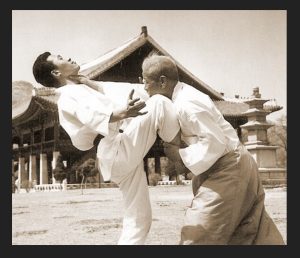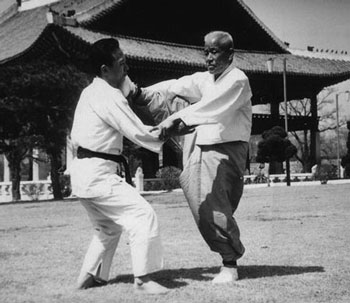Free offer
Receive MY
A Disciplined MInd
Get a FREE copy of my new eBook on a Disciplined Mind: The Key to Success now!

The world Budo Alliance is proud to present the History of Taekkyon. Important to note that Taekkyon is a traditional bare-hand martial art developed by the Korean people. And is also recognized as the original form of bare-hand martial arts in Korea.
Before the 6th century, Taekkyon was practiced by the ruling classes. Most of all from the 9th to 12th century became very popular, even among the common people. And according to the Koryusa, a Korean history book written in the 15th century, Taekkyon was widely encouraged and practiced by everyone from the king himself to farmers.
Therefore this trend continued until the early Chosun Dynasty.
But as the society moved toward a system that encouraged intellectual pursuits, discouraged military pursuits, the practice of Taekkyon declined. Hence by the 13 century, Taekkyon was considered a folk custom rather than an actively practiced martial art. This is not uncommon as the arts have always had peaks and valleys of training. You can see this today in the Western Culture.
Most importantly during the Japanese colonial period, Taekkyon was banned and nearly vanished. This condition is seen with many martial arts of the modern era. And fortunately Song Duk-ki (1893-1987) preserved the art and handed it down to modern day Koreans. Therefore after the independence of Korea, the practice of Taekkyon became considerably less popular. More popular were the practice of Japanese based arts. Importantly the establishment of Taekwondo after the Korean War and its subsequent popularity served to further overshadow the practice of Taekkyon. Very importantly today Taekwondo is still one of the moat practiced martial arts in the world.
And Taekkyon began to rise in popularity again in the early 1980s. And this was partly due to the excitement caused by the Karate Kid movie. It was designated by the government as Important Intangible Cultural Asset No. 76 on June 1, 1983. This was owing to the extensive efforts by Shin Han-seung (1928-1987). Shin learned Taekkyon from Song Duk-ki.
Most of all after the death of both masters, Lee Yong-bok, who learned Taekkyon from these two masters in 1984. Thus established the Korea Traditional Taekkyon Institute to revive Taekkyon. Through his efforts, a resurgence in Taekkyon practice resulted and on June 30, 1985, the first Taekkyon game in 80 years took place in Kooduk stadium located in Pusan.
And on Jan. 1, 1991, the Korea Taekkyon Association was established. Thereby Taekkyon became an official member of the National Sports Council for All. On Feb. 2, 2001. Therefore the Korea Taekkyon Association entered officially into the Korea Sports Council. And Taekkyon (under the auspices of the Korea Taekkyon Association) has been approved as a specialty sport by the Korea Sports Council. The Korea Taekkyon Association now has clubs and schools throughout Korea and supports more than 160 institutions. Plus 110 university circles and 120 citizens’ clubs. It also has about 10 nationwide Taekkyon championship games every year.
Taekkyon has origins dating back to Korea's Jeongjo reign (1776 to 1800). And during which it was first mentioned in a book titled "Manmulbo." The art was described as being a combative practice in which practitioners fought against each other using their hands and feet. However, it wasn't until the turn of the 20th century when Taekkyeon became widely popular in Korea's capital city of Seoul. This was due, in part, to a book published by Song Duk-ki, in which he discusses Taekkyeon and its importance as a martial art.
One of the great things about Taekkyon is that it incorporates a variety of elements into the art. Although kicking is the primary focus, practitioners are encouraged to use other body parts to attack and defend against an opponent. For example, practitioners of Taekkyon can use leg locks, hand locks and even head butts. When learning Taekkyon, practitioners must hone individual skills like knee jabs, jumps and kicks, which they can use to improve their Taekkyon proficiency.

Taekkyon is still practiced by thousands of people, many of whom prefer it over other Korean martial arts. In 1983, Song Duk-ki was largely responsible for modernizing the art. And he was given the highly acclaimed "living national treasure" status by the Korean government. He died shortly thereafter, but his presence continues to be felt through the world of Taekkyon.
Almost everybody has heard of Taekwondo and Hapkido these days. But Taekkyon, the original martial art of Korea, practiced by Korea’s ancient warrior dynasties is practically unheard of.
Most important it was almost wiped out during the Japanese colonization of Korea, it is now making a revival.
The Tae Kwon Do that is taught today is not a unique and exclusive product of Korean culture. People tend to get Tae Kwon Do and Taekkyon, an ancient Korean martial art mixed up. Tae Kwon Do is a combination of Taekkyon and Japanese Shotokan Karate. And the style mandated during the Japanese occupation of Korea. Taekkyon IS the original bare hand martial art style that’s unique to Korean history. And is the subject of much confusion and argument among historians. However I will add, because the Korean government is actively involved history will tend to be based on Propaganda. This is not to knock the Korean government specifically. Governments LIE.
The history of Taekkyon goes back to the mid Joseon Dynasty, around the 1700s. And where it was practiced as a competitive sport. It’s believed that Taekkyon evolved out of an even older, but now lost, extinct combat art called Subak. Most of all very little is known about Subak. But it’s believed that it may have been the martial art of the Hwarang warriors of the Silla Dynasty.
Taekkyon has origins dating back to Korea's Jeongjo reign (1776 to 1800), during which it was first mentioned in a book titled "Manmulbo." The art was described as being a combative practice in which practitioners fought against each other using their hands and feet. However, it wasn't until the turn of the 20th century when Taekkyon became widely popular in Korea's capital city of Seoul. And this was due, in part, to a book published by Song Duk-ki, in which he discusses Taekkyeon and its importance as a martial art.
Very importantly one of the great things about Taekkyon is that it incorporates a variety of elements into the art. Although kicking is the primary focus, practitioners are encouraged to use other body parts to attack and defend against an opponent. For example, practitioners of Taekkyon can use leg locks, hand locks and even head butts. When learning Taekkyon, practitioners must hone individual skills like knee jabs, jumps and kicks, which they can use to improve their Taekkyon proficiency.
Firstly, Taekkyon is still practiced by thousands of people, many of whom prefer it over other Korean martial arts. In 1983, Song Duk-ki -- who was largely responsible for modernizing the art. And he was given the highly acclaimed "living national treasure" status by the Korean government. He died shortly thereafter, but his presence continues to be felt through the world of Taekkyon.
They were the elite military and religious young men of that kingdom, (57BC-935AD). During this time martial arts were reserved for the ruling class, but after the fall of the Silla it became popular among the common folk. The terms “subak” (hand technique) and “taekkon” (foot technique) appear together in the writings of the Silla dynasty. This seems to confirm that hand and foot techniques were both used in Korean martial arts as they are used today in Tae Kwon Do.
During the Joseon Dynasty, (1392/1897) it fell out of popularity among the elite, who thought that educated people should stay away from martial arts and focus on scholarly topics, leaving Taekkyon to the commoners. It was probably around this time that the competitive “game” version came about as an activity for the farmers and peasant classes.
Because of the age of Taekkyon it is not possible to have a clear founder or creator. However many consider Song Duk Ki [Song Deok-Gi] to be the person responsible for the art in the 20th century. Below is a short video on Taekkyon. From the research done I would have to concur that Song is the founder of modern Taekkyon.
The video below is interesting as you can see how different the art of Taekkyon is from other Korean systems. And while there is a definite historical link from Taekkyon to Taekwondo and other Korean arts I would not say Taekkyon turned into Taekwondo as some would.
However all the arts of Korean and excellent and well worth study.
Thank you for reading the History of Taekkyon. If you enjoy these articles please share them with friends. I plan to expand this include as many martial arts as possible.
Researched by Sensei Kara Borshuk
Edited by Grand Master Art Mason